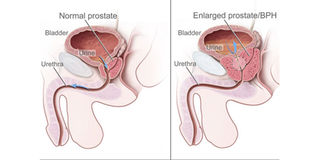Treatment options for men with enlarged prostate

Two-panel drawing shows normal male reproductive and urinary anatomy and benign prostatic hyperplasia (BPH). Panel on the left shows the normal prostate and flow of urine from the bladder through the urethra. Panel on the right shows an enlarged prostate pressing on the bladder and urethra, blocking the flow of urine.
What you need to know:
- The prostate gland is enlarged, but not cancerous, and may cause problems associated with urination.
- The condition affects up to 50 per cent of men at the age of 60 and 90 per cent of men over 85 years.
- The course of BPH in any individual is not predictable.
Frequent urination can result from drinking lots of liquids, but it could also point to a significantly larger problem in men. Multiple trips to the bathroom in the middle of the night is often a sign of benign prostatic hyperplasia (BPH), or an enlarged prostate, which is common in men over 60 years of age.
The prostate gland is enlarged, but not cancerous, and may cause problems associated with urination. The condition affects up to 50 per cent of men at the age of 60 and 90 per cent of men over 85 years. The course of BPH in any individual is not predictable. If worsening urethral obstruction is left untreated, possible complications are a thickened, irritable bladder with reduced capacity for urine; infected residual urine or bladder stones; and a backup of pressure that damages the kidneys.
What symptoms does BPH cause?
Many men with BPH have no symptoms. However, in men with symptoms, the most common include increased urinary frequency, with voiding small amounts of urine especially at night, sensation of incomplete bladder emptying after urination, difficulty in starting urination, weak urinary stream, inability to urinate, leading to catheterisation, urinary urgency, with difficulty in controlling urination and blood in the urine.
If you have symptoms, what are the treatment options?
Treatment is only necessary if symptoms become bothersome. Several treatment options are available depending on the severity of symptoms:
Lifestyle changes are appropriate for those with mild symptoms. They include limiting fluid intake in the evenings, limiting caffeine intake, healthy eating and undertaking exercise.
Prescription drugs is an option for men with symptoms that are relatively more troublesome and not relieved with lifestyle changes. The drugs include alpha blockers and 5-alpha reductase inhibitors, which relax the muscles of the prostate/bladder and reduce the volume of the prostate, respectively.
Surgery is reserved for men in whom medical therapy has not resulted in significant symptom improvement. There are many surgical options available which vary in their indications, invasiveness, effectiveness, and side-effect profile.
Examples of surgical options:
Transurethral resection of the prostate (TURP) – a common procedure in which a scope is introduced into the penis and the prostate tissue is cut away with electrical current
Laser enucleation of prostate – in this procedure, the excess prostatic tissue is destroyed by a laser
Thermal treatments – these procedures destroy excess prostatic tissue using materials such as water vapour, microwaves and other low-energy radio waves
Prostatic urethral lift – a needle is used to place implants into the prostate to aid in lifting and compressing the gland, which results in unblocking the urethra. Prostatectomy – the entire prostate gland is removed
Prostate artery embolisation (PAE) is a non-surgical treatment for men who want to avoid a traditional surgical procedure (or who are deemed high risk for surgery) in which the blood supply to the prostate gland is blocked off, resulting in its shrinkage. The success rate of PAE is over 85 per cent with a low recurrence rate. PAE resolves the problem rapidly and, as this procedure involves no open cut, normal activity can be rapidly resumed.
Are there any risks?
As with all procedures there are occasional problems that can occur, these include;
Infections. There is a small risk of urinary tract infection developing after the procedure even though antibiotics are routinely given before the procedure. Most of the time, this can be treated with simple antibiotics.
Bruising/Haematoma. This can sometimes occur at the site of access in the upper leg/left wrist, although it is usually self-limiting.
Blood in urine. This occurs in some patients but usually disappears in a day or two.
Post embolisation syndrome. Sometimes following PAE, you may experience symptoms like the flu. This usually lasts a couple of days and is simply treated with paracetamol and bed rest
Urinary retention. This is quite rare, however if it does occur, a urinary catheter will be needed for a few days until settled.
Will sexual function be affected?
Based on studies to date, patients treated with PAE for BPH have not experienced a decline in sexual function (including retrograde ejaculation and erectile dysfunction).
Dr Ravjit Sagoo is a consultant interventional radiologist at Aga Khan University Hospital Nairobi




